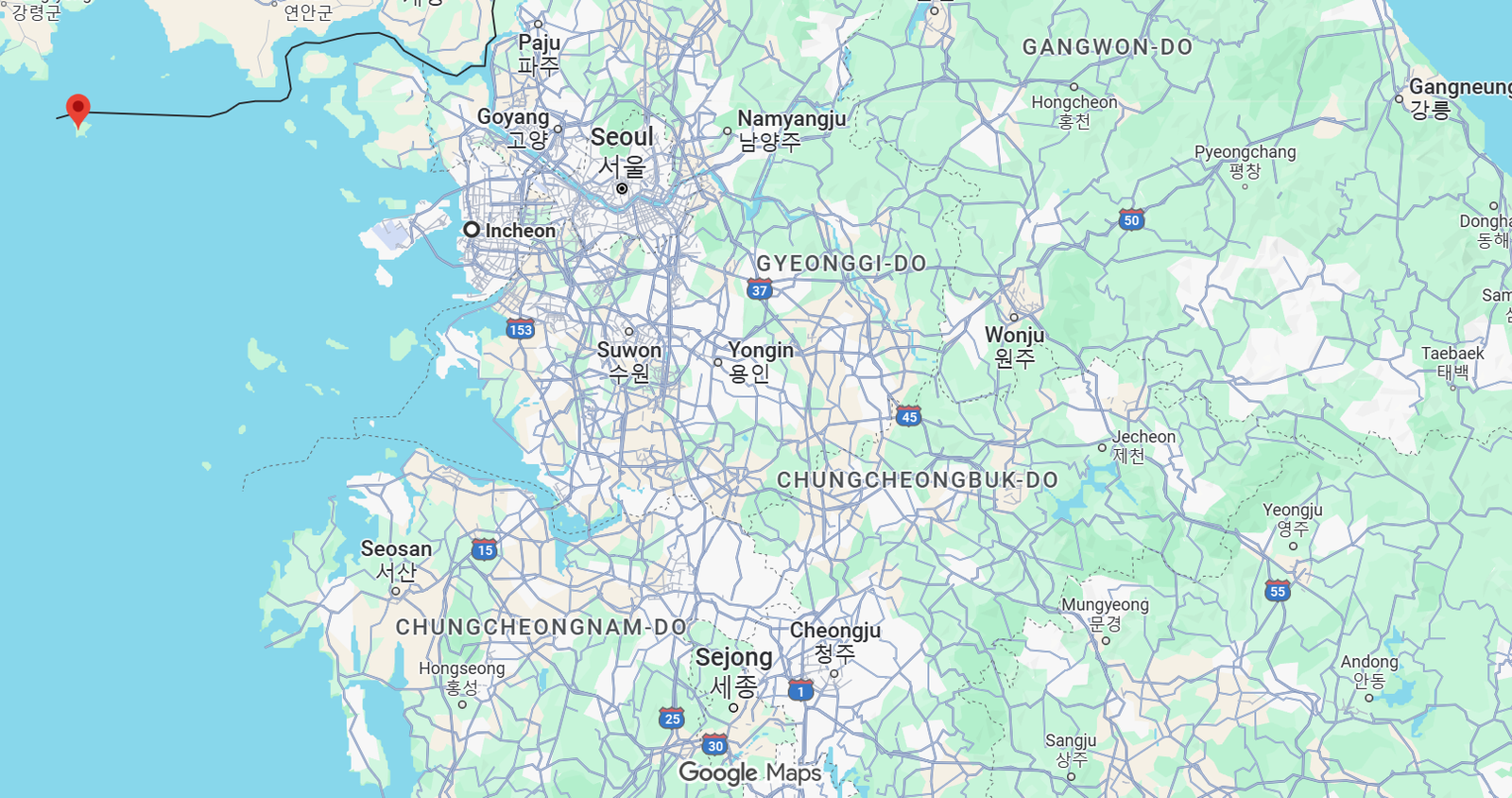Yeonpyeong Island (연평도) is one of South Korea’s most unique and fascinating destinations. Located in the Yellow Sea about 80 kilometers west of Incheon, this small fishing community offers visitors an authentic island experience far from the typical tourist trail.
Despite its proximity to North Korea and its complex history, Yeonpyeong has emerged as a secure and increasingly popular destination for travelers seeking natural beauty, fresh seafood, and a glimpse into traditional Korean island life.
Understanding Yeonpyeong Island
Yeonpyeong is actually a group of islands, with the main island being Daeyeonpyeongdo (Big Yeonpyeong Island), which covers 7.01 square kilometers and has a population of approximately 1,300 residents. The other inhabited island in the group is Soyeonpyeongdo (Small Yeonpyeong Island). The principal village and ferry port is located in Yeonpyeong-ri on the main island.
The island sits just 12 kilometers south of the North Korean coast near the Northern Limit Line (NLL), which makes it one of the westernmost territories controlled by South Korea. While this proximity to North Korea might sound concerning, the island is completely safe for tourists and is protected by South Korean military forces. In recent years, it has successfully transitioned from a sensitive military zone to a welcoming tourist destination.
Why Visit Yeonpyeong Island?
Authentic Island Experience: Unlike more commercialized Korean islands, Yeonpyeong maintains its authentic fishing village character. Life here revolves around the sea, and you’ll experience genuine Korean island culture.
Famous Seafood: The island is renowned throughout Korea for its exceptional crab fisheries. The crabs caught in these waters, particularly the blue crab and swimming crab, are considered among the finest in the country. You’ll find them featured in restaurants throughout Incheon and Seoul, but nothing beats eating them fresh on the island itself.
Natural Beauty: With rocky coastlines, sandy beaches, and relatively untouched landscapes, Yeonpyeong offers scenic beauty that feels worlds away from Korea’s bustling cities.
Unique Perspective: Visiting Yeonpyeong provides insight into life in one of Korea’s border regions and offers a different perspective on the Korean Peninsula’s division.
Here you can explore Jeju Island, Nami Island and must visit places in Seoul
Top Things to Do in Yeonpyeong Island
1. Enjoy Fresh Seafood and Blue Crabs
This is the number one reason most Koreans visit Yeonpyeong. The island’s restaurants serve incredibly fresh seafood, with blue crab (꽃게) being the star attraction. You can enjoy:
- Fresh raw fish (hoe): Caught that day and served as sashimi
- Grilled fish: Various local catches prepared simply but deliciously
- Blue crab dishes: Steamed crab, spicy crab stew (kkotge-tang), and soy sauce marinated crab (ganjang gejang)
- Seafood stews and soups: Made with the freshest local ingredients
Many restaurants are clustered near the ferry terminal in Yeonpyeong-ri. The locals are proud of their seafood, and portions are typically generous. Don’t be surprised if the owner comes from the kitchen to explain the catch of the day or how it was prepared.
2. Explore the Beaches and Coastline
Yeonpyeong has several beautiful beaches and coastal areas perfect for walking, photography, and relaxation:
- Sandy beaches: Great for leisurely walks and enjoying the ocean views
- Rocky shorelines: Interesting formations and tide pools to explore
- Sunset viewing spots: The western location makes for spectacular sunsets over the Yellow Sea
The beaches aren’t as developed as those in touristy areas, which is part of their charm. You’ll often have large stretches of sand to yourself.
3. Visit Chungmin Temple (충민사)
This historic temple commemorates the once-abundant but now extinct yellow corvina fish that was historically important to the island’s economy and culture. The temple offers insight into the island’s fishing heritage and provides a peaceful spot for reflection.
4. Observe Island Life and Fishing Activities
Take time to walk around the villages and harbor areas. You can:
- Watch fishing boats come and go from the port
- See fishermen preparing their nets and equipment
- Observe the fish markets and seafood processing
- Chat with friendly locals (many are happy to share stories about island life)
The best time for this is early morning when the fishing boats return, or late afternoon when they prepare for the next day’s work.
5. Hiking and Nature Walks
While Yeonpyeong isn’t known for dramatic mountain hiking, there are several walking trails and paths that take you through the island’s natural landscapes. The island’s relatively small size makes it easy to explore on foot or by rented bicycle.
6. Visit During Festivals
If you can time your visit with local festivals or celebrations, you’ll get an even richer cultural experience. Check with the Ongjin County tourism office for festival dates.
How to Get to Yeonpyeong Island
Ferry from Incheon (Primary Method)
The only way to reach Yeonpyeong Island is by ferry from Incheon Port International Passenger Terminal (인천항국제여객터미널).
Incheon Port Terminal Location:
- Address: 33, Yeonan-dong, Jung-gu, Incheon
- Easily accessible from Seoul and Incheon
Ferry Schedule:
- Typically 1-2 ferries per day to Yeonpyeong
- Common departure times: Morning (around 8:00-9:00 AM) and sometimes afternoon
- Return ferries: Usually afternoon/evening
- Journey time: Approximately 4-5 hours each way
- Important: Schedules vary by season and can change due to weather conditions
Booking Ferry Tickets:
- Online Booking: Visit the Incheon Port International Passenger Terminal website (www.icferry.or.kr) – Note that the English version may have limited functionality
- Phone Reservation: Call the terminal or ferry company directly (Korean language helpful)
- In-Person: Purchase tickets at the terminal on the day of departure (arrive early as space is limited)
- Ferry Companies: The primary operator for Yeonpyeong routes changes periodically, so check current operators when planning
Ferry Ticket Prices:
- One-way adult fare: Approximately 30,000-40,000 KRW
- Round-trip: Around 60,000-80,000 KRW
- Children and seniors may receive discounts
- Prices can vary by season and ferry class
Important Ferry Information:
- Weather Dependency: Ferries to Yeonpyeong are highly dependent on weather conditions. The Yellow Sea can be rough, and services are frequently canceled due to high waves or storms
- Final Confirmation: Ferry operations are determined at 6:30 AM on the day of departure based on weather
- Motion Sickness: The journey can be choppy. Consider bringing motion sickness medication if you’re prone to seasickness
- Bring ID: You’ll need to present identification (passport for foreigners) when purchasing tickets and boarding
- Early Arrival: Arrive at the terminal at least 30-60 minutes before departure
Getting to Incheon Port Terminal from Seoul
By Subway and Bus:
- Take Seoul Subway Line 1 to Dongincheon Station (동인천역)
- Exit and take a bus or taxi to Incheon Port Terminal (approximately 10-15 minutes)
By Taxi/Car:
- Direct taxi from Seoul: 1-1.5 hours depending on traffic, approximately 50,000-70,000 KRW
- Driving: Take Gyeongin Expressway to Incheon Port area (parking available at terminal)
By Bus:
- Various express buses connect Seoul to Incheon with stops near the port area
- Check specific routes from your location in Seoul
Getting to Incheon Port Terminal from Incheon Airport
By Taxi: Approximately 30-40 minutes, 25,000-35,000 KRW
By Bus and Subway: Take the Airport Railroad Express (AREX) to Incheon Station or Dongincheon Station, then transfer to local bus or taxi to the terminal
Best Time to Visit Yeonpyeong Island
Spring (April-May):
- Pleasant weather
- Fewer crowds than summer
- Good seafood availability
- Pros: Comfortable temperatures, beautiful clear days
- Cons: Can still be windy
Summer (June-August):
- Peak tourist season
- Warmest weather for beach activities
- Most crowded period
- Pros: Best for swimming, longest days
- Cons: Hot and humid, more expensive, need advance bookings
Fall (September-October):
- Excellent choice for visiting
- Comfortable temperatures
- Outstanding seafood (crabs particularly good)
- Beautiful autumn colors
- Pros: Great weather, fewer crowds than summer, prime crab season
- Cons: Can be windy
Winter (November-March):
- Coldest period
- Fewer tourists
- Ferry services more frequently canceled due to rough seas
- Pros: Very quiet and authentic experience, fresh winter seafood
- Cons: Cold winds, rough seas, limited ferry service
Recommendation: Fall (September-October) is generally considered the best time to visit for optimal weather and the finest crabs.
Yeonpyeong Island is worth visiting if you’re looking for an authentic, off-the-beaten-path Korean experience. It’s not for everyone – there are no major tourist attractions, luxury hotels, or English-friendly infrastructure. However, if you enjoy:
- Fresh, exceptional seafood
- Authentic cultural experiences
- Natural coastal beauty
- Quiet, uncrowded destinations
- Photography opportunities
- Meeting local people

